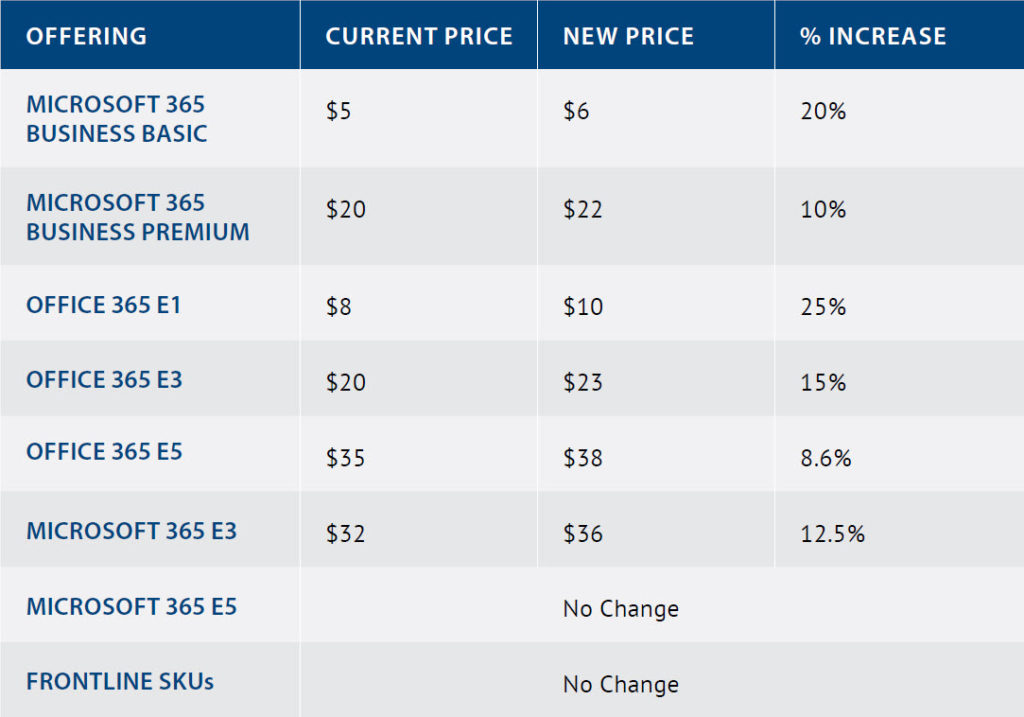
SMARTSPEND™ BULLETIN
How to Neutralize the Impact of New Microsoft 365 Pricing
New pricing changes from Microsoft will mean higher costs for many commercial Office 365 and Microsoft 365 offerings. While some claim the cost increase is justified, the impact on customers’ wallets will be significant – but, for some enterprises, avoidable.
Effective March 1, 2022, Microsoft has increased pricing by anywhere from 8.6 percent to 25 percent for many of its 365 offerings. This is the first price increase the vendor has announced since launching Office 365 (and subsequently Microsoft 365) over a decade ago. These increases, as noted below, are applied globally with local market adjustments for certain regions.

Per Microsoft’s announcement, the decision to raise prices reflects the increased customer value and the continuous re-investment the vendor has made to meet changing customer requirements. For the most part, these assertions are fair and justify Microsoft’s pricing revisions. Since the introduction of Microsoft 365 four years ago, more than 24 apps have been added to the suites as well as 1,400 new features and capabilities.
On average, NPI’s License Optimization Assessment services have helped clients eliminate 10 to 20 percent of toxic spend on their 365 estates. It’s a highly effective way to minimize or neutralize Microsoft’s price increase.
3 Ways to Avert Sticker Shock Ahead
Microsoft’s price increases are well-aligned with one of its core motivations for enterprise customers – to drive them from O365 to M365 as well as up the M365 stack to its E5 offering. Whether customers choose to move up the stack or not, the cost impact of these changes will be significant for many enterprises.
As customers approach their renewals with Microsoft, there are three ways they can neutralize or minimize the financial effects:
- Get rid of excess and underutilized license before your next renewal. One way to offset the M365 price increase is to be sure you are not renewing excess licensing on autopilot. One action customers can take is to perform a License Optimization Assessment on their 365 estates to validate actual usage and determine opportunities to right-size or liberate licenses. By assigning best-fit license types to each user and reclaiming license waste (e.g. no-pulse licenses, inactive users, etc.), customers can typically cut the renewal demand baseline by 10 to 20 percent, which can neutralize some or all of the price increase.
- Optimize your Microsoft EA. A powerful byproduct of a Microsoft license optimization assessment is the ability to accurately determine what should be purchased under your next EA renewal because you have a fact-based baseline on which to build your future-state requirements. This will ensure you buy only what you need and select the best-fit license types for your user profiles and business model. Questions to ask include:
- Which mix of licensing options will best fit your verified usage requirements and projected future demand?
- What are the cost implications for different licensing scenarios?
- What licensing strategy is optimal for your technical and business requirements over the full term of your agreement?
- In addition to license optimization, customers should make sure their EA includes protections that reduce cost risk over the term their EA. This includes IT price benchmark analysis to ensure pricing and discounts are either at or better than fair market, as well as the strengthening of terms that covers compliance-related language, SLAs, data ownership, etc.
Proactive Approach to Keeping Microsoft Costs in Check
It’s important to point out how common “bloat” is across enterprise customers’ Microsoft estates, and the waterfall effect it can have on spend. Excess licenses, subpar pricing and discounts, and inflexible contractual T&Cs have a way of getting institutionalized. When Microsoft makes changes to its pricing or licensing – or a customer renews historical licenses in an EA on autopilot (which happens too often) – the cost impact can be significant and exponential.
Considering the scale of Microsoft’s recent price increase, NPI advises enterprise O365/M365 customers to prioritize EA renewal hygiene. This means carefully analyzing usage, right-sizing license and subscription choices accordingly, and optimizing all aspects of their EA for maximum savings.